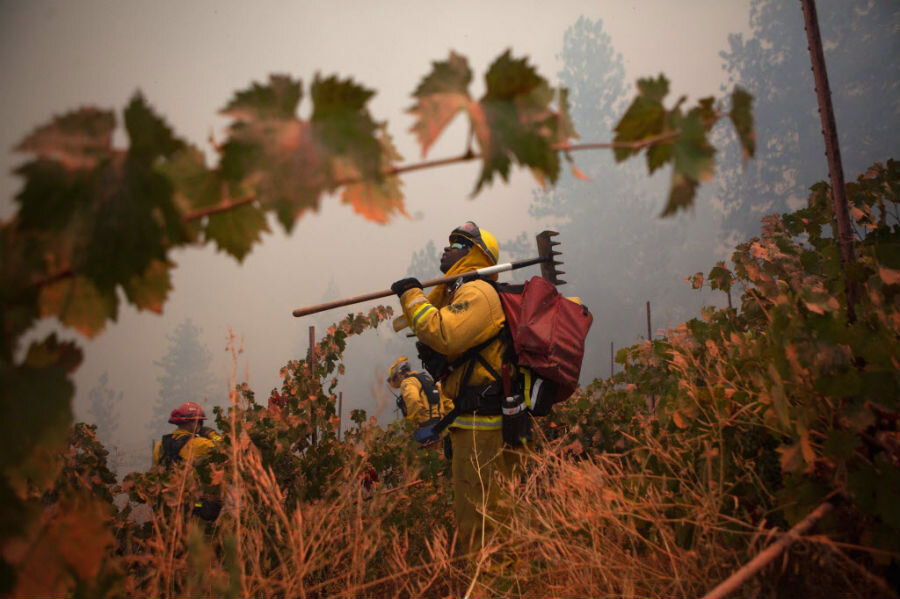Hundreds flee as two California wildfires threaten homes
Loading...
| Plymouth, Calif.
Fire crews were battling two fast-moving wildfires in California that threatened many homes and forced hundreds of evacuations, officials said.
A fire in the Sacramento region had mushroomed to about 4,000 acres by late Saturday, while a blaze that began in the afternoon around Yosemite National Park threatened a small community.
The so-called Sand Fire began Friday in the Sierra Nevada foothills and has since raced through more than 6 square miles of drought-stricken grasslands east of Sacramento.
The blaze, which has burned five homes and seven outbuildings, led to evacuation orders covering about 515 homes in and around the River Pines Estates community in Amador County.
"The fire's moving in and around homes in the area," said Lynn Tolmachoff, a spokeswoman for the California Department of Forestry and Fire Protection. "The leading edge is bumping up against residences as we speak."
The fire was only 20 percent contained by nightfall despite efforts by 1,464 firefighters and aircraft that included a DC-10 air tanker.
CalFire says a vehicle that drove over dry vegetation started the fire, which has sent up huge plumes of smoke and worsened air quality in the Sacramento area.
Firefighters battled the flames through the day in triple-digit temperatures. At first, the fire moved away from vineyards in the Shenandoah Valley, but a mid-afternoon wind change caused the flames to split and some crossed fire lines and headed down into a section of the wine country, Tolmachoff said.
The wildfire burned within 200 yards of the Story Winery in Plymouth on Friday, and the business was closed Saturday.
"We've got CalFire guys using our tasting room as a lookout point," owner Rob Campbell told the Sacramento Bee.
Sunset brought some relief, with slightly cooler and calmer weather.
"The wind has died down. It's definitely helping the firefighters out," Tolmachoff said. "We're not seeing the large flames. But now it's extremely smoky."
Meanwhile, a 500-acre fire that began Saturday afternoon threatened homes and cabins in Yosemite. Evacuations were ordered in Foresta, a community of about 45 homes inside the park where many park employees live, spokeswoman Kari Cobb said.
An additional six homes outside the park also were evacuated, she said.
The area is well away from the heavily touristed Yosemite Valley, but road closures could add a half-hour to the drive in for park visitors, Cobb said.
About 300 firefighters were battling the blaze in an area scorched in a 2009 fire, Cobb said.
Wildfires also burned in other Western states. The nation's largest wildfire, the 618-square-mile Buzzard Complex in eastern Oregon, was 95 percent contained Saturday as crews also battled other fires in the state.
There was also progress on Washington's largest wildfire, the 390-square-mile Carlton Complex in north-central part of the state, which was almost 60 percent contained. Cooler weather and rain helped firefighters get a handle on the lightning-caused fire, but heat and wind picked up Saturday. Officials increased their estimate of burned homes from 150 to 300 Friday.
In Utah, evacuation orders for 200 homes in Summit County and 10 homes in Utah County were lifted. No homes burned and there were no injuries. One of the fires started early Saturday when two teenagers playing with fireworks ignited dry grass and brush, police said.
Other wildfires burned in Utah, Colorado and other states in the West.
The fierce wildfire season has rapidly burned through firefighting budgets, the Monitor's Brad Knickerbocker reported last week.
[F]irefighting agencies such as the US Forest Service and the US Department of the Interior have to raid other fire-related programs – forest management and fire preparedness, for example – to battle the blazes.
The reasons for this are multiple and complicated: Years of fire suppression instead of letting fires burn naturally allowed fuel levels to grow dangerously; climate change has brought on changes in weather patterns; and housing and other development pushed into what’s known as the “wildland-urban interface” – some 60 percent of all new homes built since 1990, according to environmental economist Ray Rasker.







